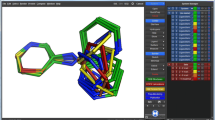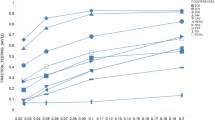Abstract
The acronym “CADD” is often used interchangeably to refer to “Computer Aided Drug Discovery” and “Computer Aided Drug Design”. While the former definition implies the use of a computer to impact one or more aspects of discovering a drug, in this paper we contend that computational chemists are most effective when they enable teams to apply true design principles as they strive to create medicines to treat human disease. We argue that teams must bring to bear multiple sub-disciplines of computational chemistry in an integrated manner in order to utilize these principles to address the multi-objective nature of the drug discovery problem. Impact, resourcing principles, and future directions for the field are also discussed, including areas of future opportunity as well as a cautionary note about hype and hubris.
Similar content being viewed by others
References
Ralph P, Wand Y (2009) A proposal for a formal definition of the design concept. In: Design requirements engineering: a ten-year perspective, volume 14, lecture Notes in business information processing. Springer-Verlag, pp 103–136
https://grants.nih.gov/grants/peer_review_process.htm#scoring2. Accessed 5 Jan 2017
Van Aller GS et al (2016) Structure-based design of a Novel SMYD3 inhibitor that bridges the SAM-and MEKK2-binding pockets. Structure 24:774–781
Westaway SM et al (2016) Cell penetrant inhibitors of the KDM4 and KDM5 families of histone lysine demethylases. 2. Pyrido [3, 4-d] pyrimidin-4 (3H)-one derivatives. J Med Chem 59:1370–1387
Bamborough P et al (2015) Structure-based optimization of naphthyridones into potent ATAD2 bromodomain inhibitors. J Med Chem 58:6151–6178
Woolford AJ-A et al (2016) Exploitation of a novel binding pocket in human lipoprotein-associated phospholipase A2 (Lp-PLA2) discovered through X-ray fragment screening. J Med Chem 59:5356–5367
Demont EH et al (2015) J Med Chem 58:5649–5673
Bamborough P et al (2016) Fragment-based discovery of low-micromolar ATAD2 bromodomain inhibitors. ACS Med Chem Lett 7:552–557
Amour A et al (2016) Evolution of a novel, orally bioavailable series of PI3Kδ inhibitors from an inhaled lead for the treatment of respiratory disease. J Med Chem 59:7239–7251
Thansandote P et al (2015) Improving the passive permeability of macrocyclic peptides: balancing permeability with other physicochemical properties. Bioorg Med Chem 23:322–327
Waring MJ et al (2015) An analysis of the attrition of drug candidates from four major pharmaceutical companies. Nat Rev Drug Disc 14:475–486
Bayliss MK et al (2016) Quality guidelines for oral drug candidates: dose, solubility and lipophilicity. Drug Discov Today 21:1719–1727
Gathiaka S et al (2016) D3R grand challenge 2015: Evaluation of protein–ligand pose and affinity predictions. J Comput Aided Mol Des 30:651–668. doi:10.1007/s10822-016-9946-8
LaBute MX, Zhang X, Lenderman J, Bennion BJ, Wong SE, Lightstone F (2014) Adverse drug reaction prediction using scores produced by large-scale drug-protein target docking on high-performance computing machines. Plos One 9(9):1–13
Reardon S (2013) Project ranks billions of drug interactions. Nature 503:449–450
Ma J, Sheridan RP, Liaw A, Dahl G, Svetnik V (2015) Deep neural nets as a method for quantitative structure–activity relationships. J. Chem. Inf. Model. 55(2):263–274
Stone JE et al (2010) GPU-accelerated molecular modeling coming of age. J Mol Graph Model 29:116–125
Lenselink EB et al (2016) Predicting binding affinities for GPCR ligands using free-energy perturbation. ACS Omega, 1:293–304
Dossetter A et al (2013) Matched molecular pair analysis in drug discovery. Drug Discov Today 18:724–731
Bøgevig A et al (2015) Route design in the twenty-first century: the IC SYNTH software tool as an idea generator for synthesis prediction. Org Proc Res Dev 19:357–368
https://www.opentargets.org/. Accessed 5 Jan 2017
Bakan A et al (2012) Druggability assessment of allosteric proteins by dynamics simulations in the presence of probe molecules. J Chem Theory Comput 8:2435–2447
Guvench O, MacKerell AD Jr (2009) Computational fragment-based binding site identification by ligand competitive saturation. PLoS Comput Biol 5(7):e1000435. doi:10.1371/journal.pcbi.1000435
Cherkasov A et al (2014) QSAR modeling: where have you been? Where are you going to? J Med Chem 57:4977–5010
Reker D, Schneider G. (2015) Active-learning strategies in computer-assisted drug discovery. Drug Discov Today 20:458–465
Besnard J et al (2012) Automated design of ligands to polypharmacological profiles. Nature 492:215–220
Acknowledgements
The authors thank Bon Jovi, whose song “Bad Medicine” provided an inspiration for our title.
Author information
Authors and Affiliations
Corresponding author
Rights and permissions
About this article
Cite this article
Manas, E.S., Green, D.V.S. CADD medicine: design is the potion that can cure my disease. J Comput Aided Mol Des 31, 249–253 (2017). https://doi.org/10.1007/s10822-016-0004-3
Received:
Accepted:
Published:
Issue Date:
DOI: https://doi.org/10.1007/s10822-016-0004-3




